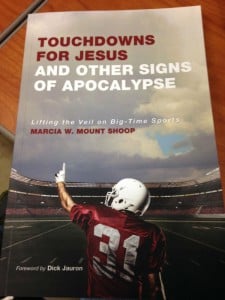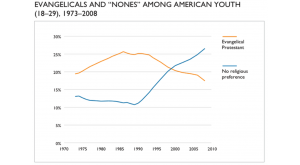A recent article in Humanities has caused me to give some thought to the audience for a work of art. An abiding criticism of so-called “serious” or “fine” art, like poetry and painting, is its elitism—only a small coterie of followers, most of them professor-types and intellectuals, seem to care. The audience for a painting or a poem is minuscule compared to the audience for a Hollywood movie, Showtime television series, or Youtube viral video. “Elitism” in this context is simply another way of describing irrelevance.
Curiously, many evangelical thought leaders who take culture seriously agree tacitly with this conclusion. Poetry and painting are marginal cultural practices at best because their audiences are so small. Therefore, they are not popular enough to be “influential” in the culture; that is, become useful tools in the service of shaping public policy (i.e., politics). It is much more effective, the unstated argument goes, to spend our time on those cultural practices and artifacts that attract large audiences than it is to attend to a painting or a poem, whose reach is extremely limited. There just aren’t enough people around a painting or a poem, not enough heads and hearts to influence.
This situation begs many questions about the nature of cultural witness and and whether there are some cultural practices that resist being used as tools for tinkering with public policy, as if that were the only goal of faithful evangelical cultural witness.
Most popular cultural artifacts that attract or create a large audience do so for a discrete moment, maximizing its opportunity for its fifteen minutes of fame—the song, television show, or YouTube video that “everyone” seems to be talking about. For many evangelical cultural commentators, it is this moment that attracts their attention. But as quickly as it spikes, so often as quickly does it disappear from memory. There is certainly a need for cultural commentary in the midst of these white-hot fifteen minutes, for discerning reflection on where large audiences seem to be.
But what of poems and paintings, those cultural artifacts that never become “popular” in any conceivable sense? Are these works destined for irrelevance?
Serious art seems to attract an audience differently. While the sitcom or top 40 hit is our culture talking to itself, the work of art, whether a poem in an anthology or a painting in a museum, comes to us from someplace else. It speaks into our cultural moment. The Spanish philosopher Ortega Y Gassett once said that every work of art is contemporary, because we experience it here and now, even though the painting was made by a man in Holland in the eighteenth century or a woman in Taos in the early twentieth. Poems and paintings seem to create their audience, slowly, through time.
In fact, unlike the sitcom, Hollywood film, top 40 hit, the poems and paintings that are made today seem to be made for another audience, a future audience. Poems and paintings are not bound to the cultural moment in which they were made. And so the following they accumulate is not limited to the historical, social, or cultural moment into which it was borne. In fact, some works, like Dickinson’s poems or Melville’s Moby-Dick, the two examples discussed in the Humanities article, seem oddly destined for a reader in the future.
In an intriguing essay, Russian poet Osip Mandelstam compares poetry to writing a last will and testament and putting it in a bottle, sealing it and tossing it into the ocean.
Wandering along the dunes many years later I happen upon it in the sand. I read the message…The message in the bottle was addressed to its finder. I found it. That means, I have become its secret addressee.
Poetry and painting seem to “find” their audience in the future. The best ones do so generation and generation, century after century, creating and then accumulating an audience that far exceeds any audience that a “viral” cultural artifact could achieve.
But what are we as evangelicals to make of this “other” kind of audience—this audience that exists through time—that cannot be mobilized to change public policy? This audience cannot be marketed to, cannot follow us on Twitter, sign a petition, or vote, reveals that there are other means by which we can be a faithful presence and bear cultural witness?
How can we as evangelicals participate in the flourishing of this community, this audience, which has been created by a poem or a painting? How can we bear witness to a future audience?
Poems and paintings that have succeeded in accruing an audience through time have done so because there were contemporary readers and viewers who sensed the significance of the work and labored diligently to reveal its significance, most often in the face of ridicule or apathy, with the belief that this poem or that painting was worth passing on to the future. These sensitive and prescient supporters believed that even though this painter or that poet had not found their audience yet, they will in the future. The job of this reader, of that viewer, was to make sure those poems and paintings reached their destined audience. Is it possible to conceive of poems and paintings that have transcended the moment of their making as eschatological, as somehow a foretaste of a future hope?
We would do well to attend to this eschatological aspiration that characterizes poems and paintings. The Humanities article reveals once again, that poems and paintings—so-called “serious” art—are weak and vulnerable things. They need help to survive the present in order to find their audience in the future. Where are those poems and paintings that are being made today that reveal that eschatological yearning?
Are we too busy following the crowds to notice this artist or that poet, whose work seems strangely out of joint with the times? And if we do find this artist or that poet, this poem or that painting, are we willing to use our cultural influence simply and merely to insure its future, to enable it to find its audience in the future?
Poems and paintings remind us that we are eschatological creatures. And that alone makes them worth our effort to cultivate, and worth our effort to pass on to the future.












